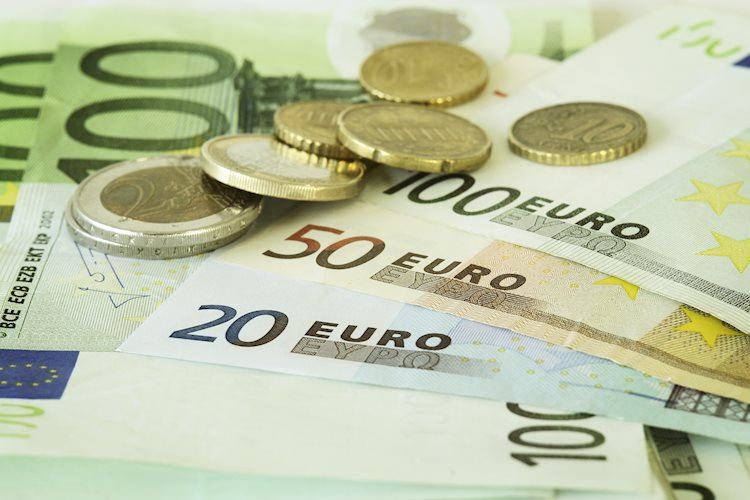- EUR/USD weakens near 1.0835 in Wednesday’s early Asian session.
- ECB’s Guindos hinted at a possible interest rate cut in September.
- US S&P Global Manufacturing PMI dropped to 49.5; Services PMI improved to 56 in July.
The EUR/USD pair trades in negative territory for the third consecutive day around 1.0835 during the Asian session on Thursday. The major pair adds to the previous day’s losses amid a downbeat view of the Eurozone’s economic outlook and rising expectation that the European Central Bank (ECB) would cut more rates in September.
Earlier this week, ECB vice president Luis de Guindos hinted at a possible interest rate cut in September as the central bank will have more information to reassess the monetary policy situation. The ECB President Christine Lagarde said last week after holding policy rates that the rate cuts in September were “wide open” amid easing inflationary pressures. The further rate cuts expectation from the ECB is likely to weigh on the Euro (EUR) in the near term.
Across the pond, market players expect the US Federal Reserve (Fed) to start cutting interest rates in September. According to the CME FedWatch Tool, traders have priced in 100% odds of a 25 basis points (bps) rate cut, while data from the Chicago Board of Trade (CBOT) showed market participants estimate 53 bps of easing for 2024.
The business activity in the US private sector continued to expand in July. The S&P Global Manufacturing PMI declined to 49.5 in July versus 51.6 prior, while the Services PMI rose to 56.0 in July from 55.3 in June, above the consensus of 54.4. The US S&P Global Composite PMI increased to 55.0 in July from 54.8 in the previous reading.
Later on Thursday, investors will closely watch the speech by the ECB’s Lagarde, along with the advanced US Gross Domestic Product (GDP) for the second quarter (Q2). The US economy is estimated to grow 2.0%, compared to the previous reading of 1.4%.
Euro FAQs
The Euro is the currency for the 20 European Union countries that belong to the Eurozone. It is the second most heavily traded currency in the world behind the US Dollar. In 2022, it accounted for 31% of all foreign exchange transactions, with an average daily turnover of over $2.2 trillion a day. EUR/USD is the most heavily traded currency pair in the world, accounting for an estimated 30% off all transactions, followed by EUR/JPY (4%), EUR/GBP (3%) and EUR/AUD (2%).
The European Central Bank (ECB) in Frankfurt, Germany, is the reserve bank for the Eurozone. The ECB sets interest rates and manages monetary policy. The ECB’s primary mandate is to maintain price stability, which means either controlling inflation or stimulating growth. Its primary tool is the raising or lowering of interest rates. Relatively high interest rates – or the expectation of higher rates – will usually benefit the Euro and vice versa. The ECB Governing Council makes monetary policy decisions at meetings held eight times a year. Decisions are made by heads of the Eurozone national banks and six permanent members, including the President of the ECB, Christine Lagarde.
Eurozone inflation data, measured by the Harmonized Index of Consumer Prices (HICP), is an important econometric for the Euro. If inflation rises more than expected, especially if above the ECB’s 2% target, it obliges the ECB to raise interest rates to bring it back under control. Relatively high interest rates compared to its counterparts will usually benefit the Euro, as it makes the region more attractive as a place for global investors to park their money.
Data releases gauge the health of the economy and can impact on the Euro. Indicators such as GDP, Manufacturing and Services PMIs, employment, and consumer sentiment surveys can all influence the direction of the single currency. A strong economy is good for the Euro. Not only does it attract more foreign investment but it may encourage the ECB to put up interest rates, which will directly strengthen the Euro. Otherwise, if economic data is weak, the Euro is likely to fall. Economic data for the four largest economies in the euro area (Germany, France, Italy and Spain) are especially significant, as they account for 75% of the Eurozone’s economy.
Another significant data release for the Euro is the Trade Balance. This indicator measures the difference between what a country earns from its exports and what it spends on imports over a given period. If a country produces highly sought after exports then its currency will gain in value purely from the extra demand created from foreign buyers seeking to purchase these goods. Therefore, a positive net Trade Balance strengthens a currency and vice versa for a negative balance.
